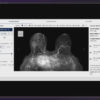New Brunswick is introducing a new means of lung cancer testing that is less invasive than its primary method.
The provincial government revealed Monday that it will begin using liquid biopsy testing to help identify the disease. This will be the first time that labs in Atlantic Canada have had access. New Brunswick’s Department of Health is partnering with AstraZeneca Canada, the local Vitalité Health Network and ResearchNB to expand the province’s testing regimen.
This technique simply involves taking a blood sample. It will be primarily utilized in patients who are unable to undergo a tissue biopsy for various reasons. They may be too feeble or have a tumour in a location that’s difficult to take a sample from.
Tissue biopsies involve removing a small piece of tissue from the body. It is therefore much more complicated on a case-by-case basis than liquid biopsies. This method may require a patient to receive anesthesia or even surgery depending on the case. They could potentially be required to get stitches afterward.
“This leading-edge approach to lung cancer testing will make it easier for patients who have health issues or hard-to-reach tumors to get access to diagnosis and treatment they need when biopsy or surgery are not feasible,” Dr. Rodney Ouellette said. He is a director at Dr. Georges-L.-Dumont University Hospital Centre’s molecular genetics lab in Moncton and founder of the Atlantic Cancer Research Institute.
Stakeholders across the health-care sector are working together to bring new innovative technologies to New Brunswick.
Liquid biopsy, a less invasive testing technology, will soon be available for lung cancer patients for whom surgical biopsies may not be feasible.… pic.twitter.com/gZNHSW2yS8
— Government of NB (@Gov_NB) September 16, 2024
Read more: Breath Diagnostics takes aim at lung cancer with One Breath
Read more: Breath Diagnostics pioneers novel lung cancer breath test
Other non-invasive testing measures emerge
Being able to accurately determine whether a patient has lung cancer without the need for a tissue sample or the use of radiation is ideal.
A low-dose computed tomography (CT) scan is the most common method of lung cancer screening in Canada and the United States today. This technique is time consuming, expensive, involves the use of radiation and has highly questionable accuracy.
In the past few years, researchers have been working to develop novel testing methods that are minimally invasive and inexpensive.
Kentucky-based Breath Diagnostics, for instance, has developed an efficient means of diagnosing the disease by taking a breath sample and analyzing it in a lab. This technology has massive implications for the lung cancer diagnostics industry. In the U.S. alone, it is estimated to be worth over US$63 billion.
Meanwhile, others have been fine-tuning artificial intelligence programs that work in tandem with X-rays to help identify the disease before symptoms even manifest. New York’s Qure.ai just presented data on its AI platform that can accomplish this at the World Conference on Lung Cancer in San Diego.
Companies and organizations in other parts of the globe have similar technologies. While X-rays do involve the use of radiation, it is a small amount.
More invasive methods being used in North America include positron emission tomography (PET) scan imaging and mediastinoscopy. Also, CT guided biopsies, bronchoscopy and thoracentesis.
rowan@mugglehead.com













